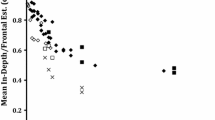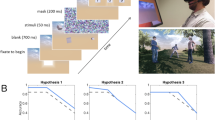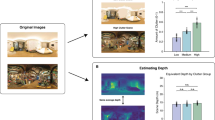Abstract
In this paper, we investigate a new approach to comparing physical and virtual size and depth percepts that captures the involuntary responses of participants to different stimuli in their field of view, rather than relying on their skill at judging size, reaching or directed walking. We show, via an effect first observed in the 1930s, that participants asked to equate the perspective projections of disc objects at different distances make a systematic error that is both individual in its extent and comparable in the particular physical and virtual setting we have tested. Prior work has shown that this systematic error is difficult to correct, even when participants are knowledgeable of its likelihood of occurring. In fact, in the real world, the error only reduces as the available cues to depth are artificially reduced. This makes the effect we describe a potentially powerful, intrinsic measure of VE quality that ultimately may contribute to our understanding of VE depth compression phenomena.









Similar content being viewed by others
References
Creem-Regehr SH, Willemsen P, Gooch AA, Thompson WB (2005) The influence of restricted viewing conditions on egocentric distance perception: implications for real and virtual environments. Perception 34:191–204
Cutting JE, Vishton PM (1995) Perceiving layout and knowing distances: the integration, relative potency, and contextual use of different information about depth. In: Handbook of perception and cognition; perception of space and motion, vol 5. Academic Press, San Diego, pp 69–117
Ellis SR, Menges BM (1998) Localization of virtual objects in the near visual field. Hum Factors 40:415–431
Gilinsky AS (1955) The effect of attitude upon the perception of size. Am J Psychol 68:173–192
Interrante V, Ries B, Anderson L (2006) Distance perception in immersive virtual environments, revisited. In: Proceedings of the IEEE conference on Virtual Reality, VR ’06. IEEE Computer Society, Washington, DC, pp 3–10
Interrante V, Ries B, Lindquist J, Kaeding M, Anderson L (2008) Elucidating factors that can facilitate veridical spatial perception in immersive virtual environments. Presence Teleoper Virtual Environ 17:176–198
Knapp JM, Loomis JM (2004) Limited field of view of head-mounted displays is not the cause of distance underestimation in virtual environments. Presence Teleoper Virtual Environ 13:572–577
Kuhl SA, Thompson WB, Creem-Regehr SH (2009) HMD calibration and its effects on distance judgments. ACM Trans Appl Percept 6:19:1–19:20
Loomis JM, Knapp JM (2003) Visual perception of egocentric distance in real and virtual environments. In: Virtual and adaptive environments applications, implications, and human performance issues. CRC Press, Boca Raton, pp 21–46
Mohler BJ, Bülthoff HH, Thompson WB, Creem-Regehr SH (2008) A full-body avatar improves egocentric distance judgments in an immersive virtual environment. In: Proceedings of the 5th symposium on applied perception in graphics and visualization, APGV ’08. ACM, New York, NY, p 194
Mohler BJ, Creem-Regehr SH, Thompson WB, Bülthoff HH (2010) The effect of viewing a self-avatar on distance judgments in an HMD-based virtual environment. Presence Teleoper Virtual Environ 19:230–242
Murgia A, Sharkey PM (2009) Estimation of distances in virtual environments using size constancy. Int J Virtual Real 8:67–74
Napieralski PE, Altenhoff BM, Bertrand JW, Long LO, Babu SV, Pagano CC, Kern J, Davis TA (2011) Near-field distance perception in real and virtual environments using both verbal and action responses. ACM Trans Appl Percept 8:18:1–18:19
Piryankova IV, de la Rosa S, Kloos U, Bulthoff HH, Mohler BJ (2013) Egocentric distance perception in large screen immersive displays. Displays 34(2):153–164
Ponto K, Gleicher M, Radwin RG, Shin HJ (2013) Perceptual calibration for immersive display environments. IEEE Trans Visual Comput Graph 19:691–700
Press WH, Teukolsky SA, Vetterling WT, Flannery BP, eds. (1992) Numerical Recipes in C: The Art of Scientific Computing, chap. Modelling of Data, 666–668. Cambridge University Press, 2nd edn
Ries B, Interrante V, Kaeding M, Anderson L (2008) The effect of self-embodiment on distance perception in immersive virtual environments. In: Proceedings of the 2008 ACM symposium on virtual reality software and technology, VRST ’08. ACM, New York, NY, pp 167–170
Sedgwick HA (1986) Space perception. In: Handbook of perception and human performance, vol 1. Wiley, New York, pp 129–158
Singh G, Swan JE II, Jones JA, Ellis SR (2010) Depth judgment measures and occluding surfaces in near-field augmented reality. In: Proceedings of the 7th symposium on applied perception in graphics and visualization, APGV ’10. ACM, New York, NY, pp 149–156
Thompson WB, Willemsen P, Gooch AA, Creem-Regehr SH, Loomis JM, Beall AC (2004) Does the quality of the computer graphics matter when judging distances in visually immersive environments. Presence Teleoper Virtual Environ 13:560–571
Thouless RH (1931a) Phenomenal regression to the real object. I. Br J Psychol Gen Sect 21:339–359
Thouless RH (1931b) Phenomenal regression to the real object. II. Br J Psychol Gen Sect 22:1–30
Willemsen P, Gooch AA (2002) An experimental comparison of perceived egocentric distance in real, image-based, and traditional virtual environment using direct walking tasks. Tech. rep., University of Utah Computer Science
Willemsen P, Gooch AA, Thompson WB, Creem-Regehr SH (2008) Effects of stereo viewing conditions on distance perception in virtual environments. Presence Teleoper Virtual Environ 17:91–101
Willemsen P, Colton MB, Creem-Regehr SH, Thompson WB (2009) The effects of head-mounted display mechanical properties and field of view on distance judgments in virtual environments. ACM Trans Appl Percept 6:8:1–8:14
Acknowledgments
We acknowledge useful discussions with Derek Wills and James Ward of the Department of Computer Science at the University of Hull. KWE was supported by a doctoral student scholarship funded by the Department of Computer Science at the University of Hull.
Author information
Authors and Affiliations
Corresponding author
Rights and permissions
About this article
Cite this article
Elner, K.W., Wright, H. Phenomenal regression to the real object in physical and virtual worlds. Virtual Reality 19, 21–31 (2015). https://doi.org/10.1007/s10055-014-0257-x
Received:
Accepted:
Published:
Issue Date:
DOI: https://doi.org/10.1007/s10055-014-0257-x




